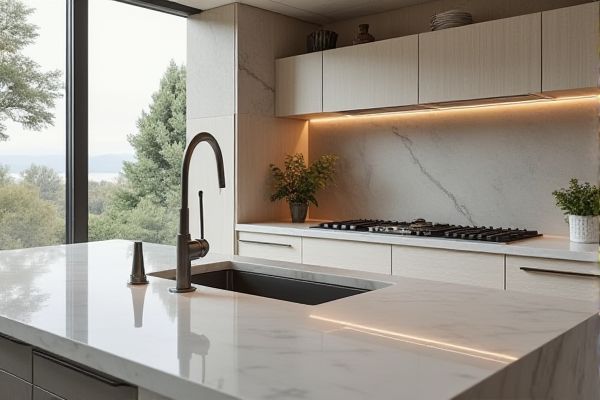
Stone countertops offer superior durability, heat resistance, and a luxurious appearance that can significantly enhance your kitchen's value, while laminate countertops provide a budget-friendly, versatile choice with easy installation and maintenance. Explore this article to discover which countertop material best suits Your lifestyle and design preferences.
Table of Comparison
| Feature | Stone Countertops | Laminate Countertops |
|---|---|---|
| Material | Natural stone (granite, marble, quartz) | Plastic laminate over particleboard or MDF |
| Durability | Highly durable, scratch and heat resistant | Moderate durability, prone to scratches and heat damage |
| Cost | High ($50 - $200 per sq. ft.) | Low ($10 - $40 per sq. ft.) |
| Maintenance | Requires sealing, easy to clean | Low maintenance, easy to clean |
| Appearance | Natural, elegant, unique patterns | Variety of colors and patterns, can mimic stone |
| Installation | Heavy, requires professional installation | Lightweight, easier DIY installation |
| Lifespan | 25+ years | 5-15 years |
| Resale Value | Increases home value | Minimal impact on home value |
Introduction to Stone and Laminate Countertops
Stone countertops, such as granite, quartz, and marble, offer exceptional durability, heat resistance, and unique natural patterns that enhance kitchen aesthetics. Laminate countertops consist of layers of plastic bonded to particleboard, providing an affordable and versatile option with a wide variety of colors and patterns. While stone surfaces require sealing and have a higher initial cost, laminate countertops are easier to maintain and replace, making them practical for budget-conscious homeowners.
Material Composition: Stone vs Laminate
Stone countertops are composed of natural materials like granite, marble, or quartz, offering durability and heat resistance due to their dense, mineral-based structure. Laminate countertops consist of layers of plastic bonded to particleboard or fiberboard, making them more affordable but less resistant to heat and scratches. Choosing your countertop depends on prioritizing the natural strength and elegance of stone versus the cost-effectiveness and variety of laminate options.
Aesthetic Appeal and Design Options
Stone countertops offer a luxurious aesthetic with natural veining and unique patterns that enhance any kitchen or bathroom design. Laminate countertops provide a wide range of colors and patterns, including designs that mimic stone, giving you versatile and budget-friendly options. Your choice depends on whether you prioritize the authentic elegance of stone or the customizable and affordable variety of laminate.
Durability and Longevity Comparison
Stone countertops, such as granite and quartz, offer superior durability and longevity due to their resistance to scratches, heat, and stains, making them a long-term investment for your kitchen. Laminate countertops, while more affordable, are prone to chipping, scratching, and water damage, often requiring replacement within 10-15 years. Choosing stone ensures a countertop that maintains its aesthetic appeal and functionality over decades, whereas laminate may require more frequent upkeep and replacement.
Maintenance and Cleaning Requirements
Stone countertops, such as granite and quartz, require sealing periodically to prevent staining and maintain their durability, and cleaning typically involves mild soap and water without abrasive cleaners. Laminate countertops are more resistant to staining and do not need sealing, but they can be damaged by harsh chemicals and excessive moisture, necessitating gentle cleaning with non-abrasive cleaners. Stone surfaces generally demand more attention to maintenance but offer longer-lasting durability, whereas laminate countertops are easier to clean but less resistant to heat and scratches.
Cost and Budget Considerations
Stone countertops, such as granite or quartz, typically range from $50 to $150 per square foot, making them a more premium investment compared to laminate countertops, which usually cost between $10 and $40 per square foot. While stone offers superior durability and timeless appeal, laminate provides a budget-friendly option with a wide variety of colors and patterns, ideal for those looking to maximize style without overspending. Your choice should balance long-term value and initial cost, considering factors like installation fees and maintenance requirements.
Installation Process and Complexity
Stone countertops require professional installation due to their heavy weight and need for precise cutting and sealing, which can increase complexity and costs. Laminate countertops are lighter and easier to install, often allowing for DIY installation with basic tools and minimal preparation. Your choice depends on whether you prefer a durable, intricate installation with stone or a quicker, more affordable setup with laminate.
Environmental Impact and Sustainability
Stone countertops, such as granite and quartz, have a higher environmental impact due to quarrying, energy-intensive processing, and transportation, yet their durability and longevity contribute to sustainability by reducing replacement frequency. Laminate countertops, made from composite materials with a plastic resin surface, typically involve lower initial environmental costs but have shorter lifespans and limited recyclability, increasing waste over time. Choosing stone countertops supports a sustainable lifecycle when considering durability and natural materials, while laminate offers a more affordable but less eco-friendly option with higher replacement rates.
Pros and Cons: Stone Countertops
Stone countertops offer unmatched durability and heat resistance, making them ideal for heavy kitchen use. They provide a natural, high-end aesthetic with unique patterns but require periodic sealing to prevent stains and can be costly compared to laminate options. Your choice depends on balancing long-term investment and maintenance against initial affordability.
Pros and Cons: Laminate Countertops
Laminate countertops offer an affordable, wide range of colors and patterns, making them a versatile choice for budget-conscious homeowners seeking stylish options. They resist stains and are easy to clean, but they can be prone to scratches, burns, and chipping compared to tougher surfaces like stone. Your decision should weigh laminate's cost-effectiveness and design flexibility against its lower durability and potential for damage over time.
 homyna.com
homyna.com